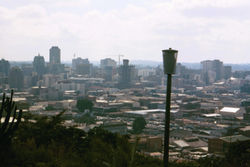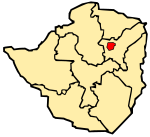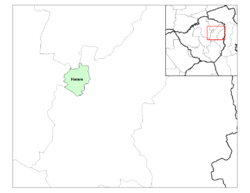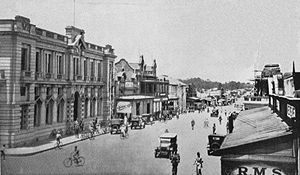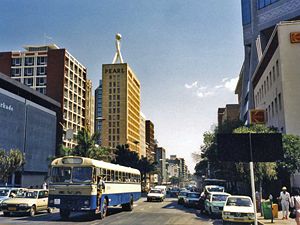Harare
2008/9 Schools Wikipedia Selection. Related subjects: Africa; Cities
| Harare, Zimbabwe | |||
| Harare, Zimbabwe from the Kopje | |||
|
|||
| Nickname(s): H Town | |||
| Motto: Pamberi Nekushandria Vanhu (Forward with Service to the People) | |||
| Map of Zimbabwe showing the location of Harare. | |||
| Coordinates: | |||
|---|---|---|---|
| Country | Zimbabwe | ||
| Province | Harare | ||
| Founded | 1890 | ||
| Incorporated (city) | 1935 | ||
| Government | |||
| - Mayor | Muchadeyi Masunda | ||
| Elevation | 1,490 m (4,888 ft) | ||
| Population ( 2006) | |||
| - City | 1,600,000 | ||
| - Urban | 2,800,111 | ||
| estimated | |||
| Time zone | CAT ( UTC+2) | ||
| - Summer ( DST) | CEST ( UTC+1) | ||
| Twin Cities | |||
| - Nottingham | United Kingdom | ||
| - Munich | Germany | ||
| - Cincinnati | United States | ||
| - Prato | Italy | ||
| - Lago | Italy | ||
| Website: http://www.hararecity.co.zw | |||
Harare (pronounced /həˈrɑreɪ/ or /həˈrɑri/, formerly Salisbury) is the capital of Zimbabwe. It has an estimated population of 1,600,000, with 2,800,000 in its metropolitan area (2006). Administratively, Harare is an independent city equivalent to a province. It is Zimbabwe's largest city and its administrative, commercial, and communications centre. The city is a trade centre for tobacco, maize, cotton, and citrus fruits. Manufactures include textiles, steel, and chemicals, and gold is mined in the area. Harare is situated at an elevation of 1483 metres (4865 feet) and its climate falls into the warm temperate category.
Harare is the site of the University of Zimbabwe, the largest and most complete institution of higher learning in Zimbabwe, which is situated about 5km north of the city. Numerous suburbs surround the city, retaining the names colonial administrators gave them during the 19th century, such as Warren Park 'D', Borrowdale, Mount Pleasant, Marlborough, Tynwald and Avondale.
History
Pioneer Column, a military volunteer force of settlers organised by Cecil Rhodes, founded the city in 1890 as a fort. They originally named the city Fort Salisbury after the 3rd Marquess of Salisbury, then British prime minister, and it subsequently became known simply as Salisbury. It was declared to be a municipality in 1897 and it became a city in 1935. Salisbury was the capital of the Federation of Rhodesia and Nyasaland from 1953 to 1963. After that point, it was the capital of Southern Rhodesia. The government of Ian Smith declared Rhodesia independent of Great Britain on November 11, 1965, and proclaimed the Republic of Rhodesia in 1970. Subsequently, the nation became the short-lived state of Zimbabwe Rhodesia; it was not until April 18, 1980, that the country was internationally recognized as independent as the Republic of Zimbabwe. The capital city retained the name Salisbury until 1982.
The name of the city was changed to Harare on April 18, 1982, the second anniversary of Zimbabwean independence, taking its name from the Shona chieftain Neharawa. It is also said the name derived from the European corruption of "Haarari" ("He does not sleep"), the epithet of the chief whose citadel was located in the area known today as the Kopje (pronounced "Koppie"). It was said that no enemy could ever launch a sneak attack on him. Prior to independence, "Harare" was the name of the Black residential area now known as Mbare.
The area at the time of founding of the city was poorly drained and earliest development was on sloping ground along the left bank of a stream that is now the course of a trunk road (Julius Nyerere Way). The first area to be fully drained was near the head of the stream and was named Causeway as a result. This area is now the site of many of the most important Government buildings, including the Senate House and the Office of the Prime Minister (now renamed for the use of President Mugabe after the position was abolished in January 1988.)
Climate
Harare has a pleasant and healthy climate. The average annual temperature is 17.95°C, rather low for the tropics, and this is due to its high altitude position and the prevalence of a cool south-easterly airflow. There are three main seasons - a warm, wet season from November to March/April; a cool, dry season from May to August (corresponding to the Southern Hemisphere winter); and a hot, dry season in September/October. Daily temperature ranges are about 7°C to 20°C in July (coldest month), about 13°C to 28°C in October (hottest month) and about 15.5°C to 25°C in January (midsummer). The hottest year on record was 1914 - 19.73°C - and the coldest year was 1965 - 17.13°C. The average annual rainfall is about 825mm in the south-west rising to 855mm on the higher land in the north-east (around Borrowdale to Glen Lorne). Very little rain usually falls during the period May to September although sporadic showers occur in most years. Rainfall varies a great deal from year to year and follows cycles of wet and dry periods that are from 7 to 10 years long. Records begin in October 1890 but all three Harare stations stopped reporting in early 2004.
The climate supports a natural vegetation of open woodland. The most common tree of the local region is the Msasa Brachystegia spiciformis that colours the landscape wine-red with its new leaves in late August. An introduced tree that contributes most to the town's atmosphere is the Jacaranda (a South American species) that produces a burst of lilac when it blooms in September.
Notable landmarks and institutions
- Barbourfields Stadium
- CBZ Holdings
- Cairns Holdings
- Data Control & Systems
- Dynamos F.C.
- Gwanzura
- 44 Harvest House
- Mbare Musika
- Mushandirapamwe Hotel
- National Gallery of Zimbabwe
- Net*One
- Parirenyatwa Hospital
- Roman Catholic Archdiocese of Harare
- Rufaro Stadium
- Sam Nujoma Street
- St. John's College, Harare
- University of Zimbabwe
- Queen Victoria Museum
- Zimbabwe Stock Exchange
- Zimbabwe grounds
- Zimbabwe Museum of Human Sciences
International Venue
Harare has been the location of several international summits such as the 8th Summit of the Non-Aligned Movement ( 6 September 1986) and Commonwealth Heads of Government Meeting (1991). The latter produced the Harare Declaration, dictating the membership criteria of the Commonwealth. In 1995, Harare hosted most of the 6th All-Africa Games, sharing the event with other Zimbabwean cities such as Bulawayo and Chitungwiza.
Transportation
A public transportation system of buses, run by ZUPCO has crumbled in recent years. Instead there has been a proliferation of privately owned companies that operate commuter omnibuses. With the advent of the fuel crisis in the country, the government introduced commuter trains in order to ease transport shortages.
Harare International Airport serves Harare. The National Railways of Zimbabwe, NRZ operate a daily overnight passenger train service that runs from Harare to Mutare and another one from Harare to Bulawayo.
News & information
Residents are exposed to a variety of sources for information, though almost all of their sources are controlled by the government. In the print media, there is the Herald, Financial Gazette, Independent, Standard, and Kwayedza. Since there has been an explossion of online media outlets. These include ZimOnline, ZimDaily, Guardian, NewZimbabwe, Times, Harare Tribune, Zimbabwe Metro and many others. The government controls all the electronic media, though Voice of America, Voice of the people and SW Radio Africa beam broadcasts into the country occassionally.
Sister cities
 Nottingham, United Kingdom
Nottingham, United Kingdom Munich, Germany
Munich, Germany
Cincinnati, Ohio, United States(Suspended in protest of recent election.) Prato, Italy
Prato, Italy Lago, Italy
Lago, Italy
